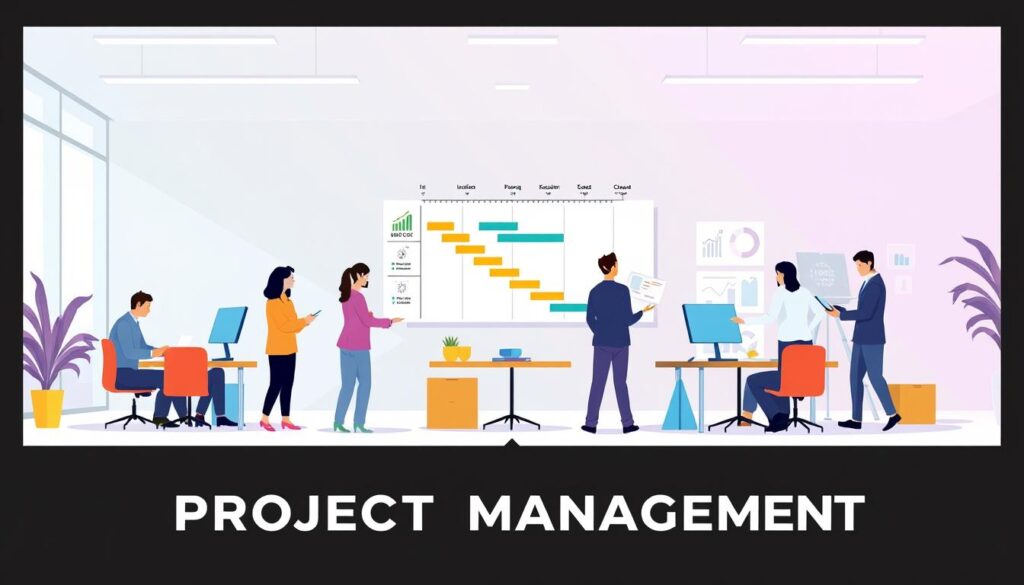Did you know that effective infrastructure project management can save up to 20% on project costs and reduce delays by 30%? With the increasing complexity of modern infrastructure projects, mastering project management tools and techniques is crucial for success.
Our Project and Infrastructure Management MSc degree is designed to equip professionals with the knowledge and skills needed to manage large-scale projects from inception to completion. By understanding the principles of effective project planning, professionals can deliver projects on time, within budget, and to the required quality standards.
Key Takeaways
- Effective infrastructure project management can save costs and reduce delays.
- Mastering project management tools and techniques is crucial for success.
- Understanding project management principles is essential for delivering projects on time and within budget.
- Professionals can benefit from specialized training in infrastructure project management.
- A clear plan is necessary for successful project execution.
Introduction to Infrastructure Project Management
The success of infrastructure projects relies heavily on robust project management practices that encompass planning, coordination, and control. Infrastructure project management is a complex field that involves managing large-scale projects such as construction, transportation, and IT infrastructure.
An Infrastructure Project Manager oversees infrastructure projects, ensuring they are completed on time, within budget, and meet the specified requirements. The role entails developing project plans, coordinating with various teams, managing project timelines and resources, and ensuring compliance with regulations and safety standards.
Definition and Importance
Infrastructure project management is defined as the application of knowledge, skills, and techniques to ensure that projects meet their intended objectives. It is crucial for delivering projects that meet the required quality, safety, and environmental standards. Effective infrastructure project management is essential for ensuring that projects are completed on time, within budget, and to the satisfaction of all stakeholders.
For more information on the basics of infrastructure project management, you can visit this resource.
Key Components of Project Management
The key components of project management include scope management, time management, cost management, quality management, and resource management. These components are interconnected and interdependent, requiring a holistic approach to project management.
| Component | Description |
|---|---|
| Scope Management | Defining and managing the project scope to ensure that all necessary work is included and that there are no unnecessary changes. |
| Time Management | Developing and controlling the project schedule to ensure that the project is completed on time. |
| Cost Management | Establishing and controlling the project budget to ensure that the project is completed within budget. |
| Quality Management | Ensuring that the project meets the required quality standards through planning, assurance, and control. |
Civil engineering plays a significant role in project management, as highlighted in resources such as this article on civil engineering in project.
Challenges in Infrastructure Projects
Infrastructure projects face numerous challenges, including regulatory compliance, stakeholder engagement, and risk management. Infrastructure Project Managers must navigate these challenges to ensure project success.
Some of the common challenges include managing stakeholder expectations, mitigating risks, and ensuring compliance with regulations and safety standards. By understanding these challenges, professionals can better manage infrastructure projects and ensure their success.
Understanding the Project Lifecycle
Understanding the various phases of a project’s lifecycle is crucial for delivering infrastructure projects on time and within budget. The project lifecycle encompasses several critical phases that guide the project from initiation to closure.

Phases of the Project Lifecycle
The project lifecycle includes initiation, planning, execution, monitoring and control, and closure. Each phase has distinct characteristics and requirements that are vital for effective project planning and management.
- Initiation: Defining project scope and objectives.
- Planning: Developing a detailed project plan, including timelines and resource allocation.
- Execution: Carrying out the project tasks as outlined in the plan.
- Monitoring and Control: Tracking project progress and making adjustments as necessary.
- Closure: Formalizing the project completion and evaluating its success.
Utilizing project management tools can significantly enhance the efficiency of each phase, ensuring that projects are well-managed and successful.
Importance of Lifecycle Management
Effective lifecycle management is essential for delivering infrastructure projects that meet their intended objectives. It ensures that projects are executed within the defined constraints of time, budget, and quality.
“A well-managed project lifecycle is the backbone of successful infrastructure development, enabling projects to be delivered on time, within budget, and to the required quality standards.”
By understanding and managing the project lifecycle effectively, professionals can make informed decisions throughout the project duration, ultimately leading to better outcomes in infrastructure development projects.
Planning and Development
Successful infrastructure projects start with robust planning and development strategies. Planning and development are critical components that lay the groundwork for project success.
Setting SMART Objectives
Setting SMART (Specific, Measurable, Achievable, Relevant, Time-bound) objectives is essential for effective project planning. It involves defining clear goals that guide the project team and stakeholders. SMART objectives ensure that projects are focused and achievable, helping to avoid scope creep and ensuring that everyone is working towards the same outcomes.
For instance, a SMART objective for a road construction project might be to “complete the construction of a new highway lane within the next 12 months, staying within a budget of $10 million.” This objective is specific, measurable, achievable, relevant, and time-bound.
Resource Allocation Strategies
Resource allocation is another vital aspect of project planning. It involves assigning the right resources (skills, materials, equipment) to the right tasks at the right time. Efficient resource allocation enables projects to be delivered on time and within budget, maximizing the use of available resources.
| Resource Type | Description | Importance |
|---|---|---|
| Human Resources | Skilled labor and project management teams | High |
| Materials | Raw materials and equipment needed for construction | High |
| Equipment | Machinery and technology required for project execution | Medium |
Effective resource allocation strategies involve identifying the resources needed, assessing their availability, and allocating them based on project priorities. This process helps in optimizing resource utilization and minimizing waste.
Risk Management in Infrastructure Projects
Risk management plays a pivotal role in ensuring the timely and within-budget completion of infrastructure projects. It involves a proactive approach to identifying, assessing, and mitigating risks that could impact the project’s success.
Identifying Potential Risks
The first step in risk management is to identify potential risks. This involves analyzing the project’s scope, timeline, and resources to determine where risks may arise. Common risks in infrastructure projects include delays, cost overruns, and quality issues. By understanding these risks, project managers can develop strategies to mitigate them.
Some of the key risks in infrastructure projects include:
- Regulatory changes
- Environmental factors
- Supply chain disruptions
- Labor shortages
Risk Mitigation Techniques
Once potential risks are identified, the next step is to develop risk mitigation techniques. This can involve diversifying suppliers, investing in insurance, or developing contingency plans. Effective risk mitigation requires a thorough understanding of the project’s risks and the ability to respond quickly to changes.

For example, a project manager might mitigate the risk of supply chain disruptions by identifying multiple suppliers for critical materials. This ensures that the project can continue even if one supplier experiences difficulties.
Monitoring and Reviewing Risks
Risk management is not a one-time task; it requires continuous monitoring and reviewing of risks throughout the project lifecycle. This involves regularly assessing the project’s risk profile and updating mitigation strategies as needed. By staying proactive, project managers can minimize the impact of risks and ensure that the project stays on track.
Effective risk management tools and techniques, such as project management software, can aid in this process by providing real-time data and insights. This enables project managers to make informed decisions and respond quickly to emerging risks.
Stakeholder Engagement
The success of infrastructure projects is often a direct result of how well stakeholders are engaged throughout the project lifecycle. Stakeholder engagement is a vital aspect of infrastructure project management that involves identifying stakeholders, developing effective communication strategies, and building lasting relationships.
Identifying Stakeholders
Identifying stakeholders is the first step in stakeholder engagement. This involves recognizing individuals and groups who have a vested interest in the project. Stakeholders can include project team members, clients, community groups, and government agencies. Effective stakeholder identification ensures that all relevant parties are considered and engaged appropriately.
To identify stakeholders, professionals can use various techniques such as stakeholder mapping and analysis. This process helps in understanding the stakeholders’ needs, expectations, and potential impact on the project.
Communication Strategies
Developing effective communication strategies is crucial for successful stakeholder engagement. This involves creating a clear plan for how information will be shared with stakeholders, taking into account their needs and preferences. Regular updates, transparent communication, and tailored messaging are key components of effective communication strategies.
A well-structured communication plan can help in building trust and ensuring that stakeholders are informed and involved throughout the project. This can include regular meetings, reports, and the use of digital communication tools.
| Communication Method | Frequency | Stakeholder Group |
|---|---|---|
| Regular Project Updates | Bi-weekly | Project Team, Clients |
| Community Newsletters | Monthly | Community Groups |
| Progress Reports | Quarterly | Government Agencies, Investors |
Building Relationships
Building relationships with stakeholders is essential for fostering trust and cooperation. This involves understanding stakeholders’ needs, being responsive to their concerns, and demonstrating a commitment to the project’s success. Strong relationships with stakeholders can lead to increased support and reduced resistance to the project.
Professionals can build relationships by being proactive, transparent, and responsive. This can involve regular engagement, feedback mechanisms, and showing appreciation for stakeholders’ contributions.
Budgeting and Financial Management
The success of infrastructure projects heavily relies on robust budgeting and financial management practices. Effective financial management ensures that projects are completed within the allocated budget, enhancing their viability and sustainability. For more insights on cost management strategies, visit strategies for cost management in engineering.
Cost Estimation Techniques
Accurate cost estimation is the foundation of successful project budgeting. Various techniques are employed to estimate costs, including:
- Bottom-up estimating, which involves detailed cost analysis of individual project components.
- Analogous estimating, which uses historical data from similar projects.
- Parametric estimating, which relies on statistical models to predict costs.
By utilizing these techniques, project managers can develop comprehensive budget plans that account for various project expenses.

Financial Monitoring Tools
Once the budget is established, financial monitoring tools play a crucial role in tracking project expenses. These tools enable project managers to:
- Monitor expenditures in real-time.
- Identify variances from the budget.
- Make informed decisions to adjust project spending.
Effective use of financial monitoring tools ensures that infrastructure projects remain financially on track, mitigating the risk of cost overruns.
Scheduling and Time Management
Effective scheduling and time management are the backbone of successful infrastructure project management. Ensuring that projects are completed on time requires a proactive approach that involves continuous monitoring and review of project timelines.
Creating Effective Timelines
Creating effective timelines is crucial for the success of infrastructure projects. This involves setting realistic milestones and deadlines, taking into account potential delays and dependencies between tasks. By doing so, project managers can identify critical path activities that determine the minimum project duration.
Key strategies for creating effective timelines include:
- Defining clear project objectives and scope
- Breaking down the project into manageable tasks
- Establishing realistic timelines and milestones
- Identifying and mitigating potential risks and delays
For more detailed strategies on construction project scheduling, visit Lumberfi’s blog on construction project scheduling.
Tools for Schedule Management
Utilizing the right tools for schedule management is vital for tracking project progress and ensuring that projects are completed according to schedule. Various software solutions are available that offer features such as Gantt charts, calendar views, and real-time updates.
Some popular tools for schedule management include:
- Project management software like Asana, Trello, or MS Project
- Gantt chart software for visualizing project timelines
- Collaboration tools for team communication and coordination
By combining effective timeline creation with the right tools for schedule management, infrastructure project managers can significantly enhance their ability to deliver projects on time and within budget.
Quality Control and Assurance
Effective quality control and assurance are pivotal in ensuring the success of infrastructure projects. These processes involve a proactive approach to maintaining high standards throughout the project lifecycle.
Defining Quality Standards
Defining quality standards is the first step towards achieving excellence in infrastructure projects. This involves setting clear, measurable objectives that align with the project’s overall goals. For instance, quality control and assurance in construction project emphasize the importance of adhering to predefined standards.
To define quality standards effectively, project managers must consider various factors, including material specifications, construction methodologies, and regulatory compliance. By establishing these standards, teams can ensure that their work meets the required specifications, thereby reducing the risk of defects and rework.

Methods for Quality Assurance
Methods for quality assurance are critical in ensuring that infrastructure projects are delivered to the required quality standards. These methods include regular inspections, testing, and continuous monitoring of project activities. By implementing these measures, project managers can identify potential issues early on, thereby preventing costly delays and rework.
Some effective methods for quality assurance include adopting total quality management (TQM) principles, which emphasize continuous improvement and employee involvement. Additionally, leveraging technology, such as project management software, can enhance quality assurance efforts by providing real-time data and insights. For more information on the objectives of engineering project management, visit objectives of engineering project management.
By combining well-defined quality standards with robust methods for quality assurance, infrastructure projects can achieve higher levels of success, ensuring that they are completed on time, within budget, and to the required quality.
Use of Technology in Project Management
Infrastructure project management has witnessed a significant transformation with the advent of advanced technologies. The effective use of technology is now a cornerstone of successful project management, enabling professionals to manage complex infrastructure projects more efficiently.
Project Management Software Solutions
Project management software solutions have become indispensable tools for infrastructure project managers. These solutions offer a range of functionalities, including project planning, resource allocation, and progress tracking. By utilizing such software, project managers can enhance collaboration among team members and stakeholders, ensuring that projects are completed on time and within budget.
Some of the key features of project management software include:
- Real-time project tracking
- Resource management
- Budgeting and cost control
- Collaboration tools
As noted by a project management expert, “The right software can make a significant difference in managing complex infrastructure projects, providing a centralized platform for all project-related information.“
Emerging Technologies in Infrastructure
Emerging technologies such as artificial intelligence (AI), blockchain, and Internet of Things (IoT) are increasingly being adopted in infrastructure project management. These technologies offer innovative solutions to traditional project management challenges, such as predictive maintenance, enhanced security, and improved data analysis.
“The integration of AI and machine learning into project management tools is revolutionizing the way we predict and manage project risks.”
The adoption of these emerging technologies is expected to continue growing, driven by their potential to improve project outcomes and reduce costs. As technology continues to evolve, it is essential for infrastructure project managers to stay abreast of the latest developments and assess their potential applications in project management.
Team Leadership and Collaboration
The success of infrastructure projects heavily relies on the synergy between team leadership and collaboration. Effective team leadership is not just about guiding the team; it’s about fostering a collaborative environment where every member can contribute their best.
Building effective teams is a critical aspect of team leadership. It involves identifying the right talent, ensuring that team members have the necessary skills, and promoting a culture of collaboration.
Building Effective Teams
A well-structured team is the backbone of any successful infrastructure project. To build such a team, leaders must focus on:
- Identifying the right talent with the necessary skills and expertise.
- Promoting a culture of collaboration and mutual respect.
- Ensuring clear communication channels are established.
As noted by a project management expert, “A team’s strength lies not just in the individual members but in how well they work together towards a common goal.”
“The way to get started is to quit talking and begin doing.” – Walt Disney
Collaborative Tools and Techniques
In today’s digital age, various collaborative tools and techniques can significantly enhance team collaboration. These include:
| Tool/Technique | Description | Benefits |
|---|---|---|
| Project Management Software | Tools like Asana, Trello, and MS Project help in task management and tracking progress. | Enhances transparency, improves task allocation, and facilitates real-time tracking. |
| Communication Platforms | Platforms like Slack and Microsoft Teams facilitate real-time communication. | Reduces email clutter, enables instant feedback, and fosters team interaction. |
Effective team leadership and collaboration require a proactive approach, involving continuous monitoring and review of team performance. By leveraging the right tools and techniques, leaders can ensure that their teams remain collaborative and focused on the project goals.

By understanding the importance of team leadership and collaboration, infrastructure project managers can drive their projects towards success, ensuring that they are completed on time, within budget, and to the required quality standards.
Regulatory Compliance and Standards
Understanding and implementing regulatory compliance is vital for infrastructure projects, as it directly impacts project timelines, budgets, and overall quality. Regulatory compliance is a critical aspect of infrastructure project management, ensuring that projects are executed in accordance with local, state, and federal regulations.
Understanding Local Regulations
Local regulations play a significant role in shaping the execution of infrastructure projects. It is essential to understand these regulations to avoid legal complications and ensure project success. For instance, familiarizing oneself with local building codes, zoning laws, and environmental regulations can significantly impact project planning and execution. Professionals can refer to resources like project management compliance guides to gain a deeper understanding of the regulatory landscape.
Ensuring Compliance Throughout the Project
Ensuring compliance throughout the project lifecycle is crucial. This involves continuous monitoring and review of regulatory requirements, adapting to changes in regulations, and maintaining detailed records of compliance efforts. Effective regulatory compliance requires a proactive approach, involving regular audits and training for project team members to stay updated on relevant laws and standards.
By prioritizing regulatory compliance, infrastructure projects can mitigate risks, avoid costly fines, and ensure that the final product meets the required standards and expectations of stakeholders.
Environmental Considerations
As infrastructure projects continue to grow in complexity, environmental considerations have become a critical component of project management. Effective environmental management is crucial for ensuring that infrastructure projects are sustainable and minimize their ecological footprint.
Incorporating Sustainability Practices
Incorporating sustainability practices into infrastructure projects involves adopting strategies that reduce environmental impact. This can include using sustainable materials, implementing energy-efficient systems, and minimizing waste. By adopting sustainable practices, project managers can not only reduce the environmental impact of their projects but also enhance their reputation and potentially reduce costs in the long term.
For instance, using locally sourced materials can reduce transportation emissions, while implementing recycling programs can minimize waste. Modern infrastructure construction practices emphasize the importance of sustainability throughout the project lifecycle.
Impact Assessment Strategies
Impact assessment strategies are essential for identifying and mitigating the environmental impacts of infrastructure projects. This involves conducting thorough environmental impact assessments (EIAs) to identify potential risks and developing strategies to mitigate them.
A comprehensive EIA should consider various factors, including air and water quality, biodiversity, and social impacts. By understanding these potential impacts, project managers can develop effective mitigation strategies to minimize harm.

| Impact Category | Description | Mitigation Strategies |
|---|---|---|
| Air Quality | Emissions from construction activities | Implement dust suppression measures, use cleaner machinery |
| Water Quality | Runoff and pollution from construction sites | Implement sedimentation ponds, use eco-friendly materials |
| Biodiversity | Habitat destruction and disruption | Conduct wildlife surveys, implement habitat restoration plans |
By incorporating sustainability practices and using impact assessment strategies, infrastructure project managers can significantly reduce the environmental footprint of their projects. This not only benefits the environment but also contributes to the long-term success and sustainability of the projects.
Case Studies of Successful Projects
Examining case studies of successful infrastructure projects reveals valuable insights into effective project management practices. By analyzing these projects, professionals can identify key factors that contributed to their success.
Lessons Learned from Successful Projects
Case studies provide a comprehensive understanding of project management strategies that have been successfully implemented. For instance, the Channel Tunnel project, also known as the Eurotunnel, is a prime example of a complex infrastructure project that required meticulous planning and execution. The project’s success can be attributed to its robust risk management strategies and effective stakeholder engagement.
Another example is the Golden Gate Bridge project, which, despite facing numerous challenges, was completed successfully due to its innovative engineering solutions and strong project leadership. These case studies highlight the importance of adaptability, teamwork, and forward-thinking in achieving project goals.
Analyzing Key Factors for Success
When analyzing successful infrastructure projects, several key factors emerge as common denominators. These include:
- Effective Planning: Comprehensive planning that includes setting clear objectives, allocating resources efficiently, and anticipating potential risks.
- Stakeholder Engagement: Engaging with stakeholders throughout the project lifecycle to ensure their needs are met and concerns are addressed.
- Innovative Technologies: Leveraging the latest technologies to improve project efficiency, reduce costs, and enhance quality.
By understanding and applying these key factors, project managers can significantly improve the likelihood of success for their infrastructure projects.
Continuous Improvement Strategies
Effective infrastructure project management hinges on the ability to continuously improve processes and practices. Continuous improvement is not just a buzzword; it’s a critical component that ensures projects are delivered efficiently, effectively, and to the required quality standards.
Importance of Feedback Loops
Feedback loops are essential for continuous improvement. They allow project managers to identify areas that need improvement, understand the root causes of problems, and implement corrective actions. By leveraging feedback from various stakeholders, including team members, clients, and end-users, project managers can gain valuable insights into the project’s performance.
For instance, a project manager might use feedback to adjust the project timeline, allocate resources more effectively, or improve communication among team members. According to Atlassian, “Feedback loops help teams reflect on their processes and identify opportunities for improvement.”
Implementing Lessons Learned
Implementing lessons learned is another crucial aspect of continuous improvement. It involves documenting the knowledge gained during the project and applying it to future projects. This can be achieved through post-project reviews, retrospectives, and knowledge-sharing sessions.
By implementing lessons learned, organizations can avoid repeating mistakes, improve their processes, and enhance their overall project management maturity. As noted by industry experts, “The key to successful project management is the ability to learn from past experiences and apply those lessons to future projects.”
| Strategy | Benefits |
|---|---|
| Feedback Loops | Improved project performance, enhanced stakeholder satisfaction, and better resource allocation |
| Implementing Lessons Learned | Avoidance of repeated mistakes, improved processes, and enhanced project management maturity |

Conclusion and Future Trends
The future of infrastructure project management is being shaped by emerging trends and challenges. As the global population continues to grow, the demand for sustainable infrastructure is intensifying, driven by the need for renewable energy, smart city technologies, and sustainable transportation systems.
Professionals in infrastructure project management must stay ahead of the curve by understanding these trends and challenges. By leveraging technologies like artificial intelligence, machine learning, and predictive analytics, the engineering community can tackle grand challenges, including climate change, resource scarcity, and urban sprawl. For more insights on tackling these challenges, visit World Civil Society.
Preparing for Emerging Challenges
Effective infrastructure project management requires a proactive approach, involving continuous monitoring and review of industry trends and challenges. By doing so, professionals can ensure that projects are delivered successfully and that the infrastructure project management profession continues to evolve and improve, addressing future trends and emerging challenges.
